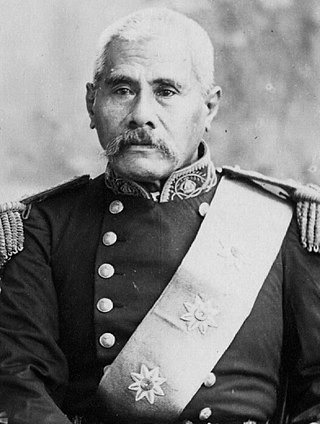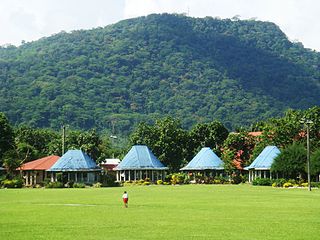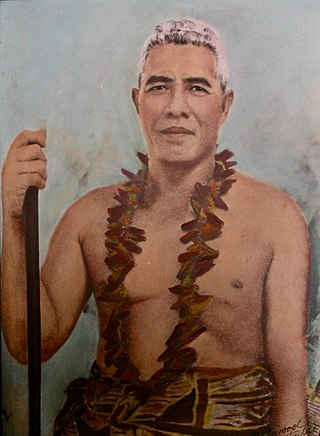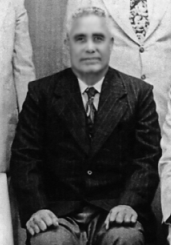 |
|---|
| Constitution |
General elections were held in Western Samoa on 15 November 1957. [1]
 |
|---|
| Constitution |
General elections were held in Western Samoa on 15 November 1957. [1]
A Constitutional Convention was held in 1954, which recommended the merger of the 41-member Fono of Faipule and the 29-member Legislative Assembly into a new 48-member Legislative Assembly with 41 elected Samoan members, five elected European members and two ministers (the Minister of Finance and Minister of Justice), [2] with the number of Samoan members rising to 45 in future in line with population increases. [3] The 41 Samoan members would be elected from the same constituencies used for the Fono of Faipule, with voting restricted to matais. [2] The five European members would be elected from a single nationwide constituency by universal suffrage for people with European status; of the 1,432 people with European status, around 175 were European, 125 Chinese and 1,100 mixed-race. [4]
The proposals also introduced cabinet government, with a Premier chosen by the Legislative Assembly, and proposed making the two Fautuas, Tupua Tamasese Meaʻole and Malietoa Tanumafili II, joint heads of state for life, which was approved by the vast majority of the 170 delegates and opposed by only around six. The decision provoked a furious response from Fiame Mata'afa Faumuina Mulinu'u II, one of the other four paramount chiefs alongside Tamasese and Malietoa, and on the final day of the convention, Mata'afa announced that he would withdraw from public life in protest at the decision. [2]
In 31 of the 41 Samoan seats, there was only one candidate, resulting in no vote taking place and the candidate being returned unopposed. The five European seats were contested by 11 candidates, including all five incumbent MLAs. Five of the European candidates (incumbent Peter Plowman and four others) ran as the Progressive Citizens League, with the rest standing as independents. [4]
In the Samoan seats, six of the incumbent MLCs were re-elected. [1] In the European seats, the Progressive Citizens League won four of the five seats, with three of the five incumbents losing their seats. [1] Around 1,100 of the 1,432 European voters voted. [1]
| Candidate | Party | Votes | % | Notes | |
|---|---|---|---|---|---|
| Eugene Paul | Progressive Citizens League | 811 | 15.98 | Elected | |
| Frank Nelson | Progressive Citizens League | 614 | 12.10 | Elected | |
| Fred Betham | Independent | 592 | 11.67 | Re-elected | |
| Peter Plowman | Progressive Citizens League | 563 | 11.09 | Re-elected | |
| Hans Joachim Keil II | Progressive Citizens League | 562 | 11.07 | Elected | |
| Harry Moors | Independent | 561 | 11.05 | Unseated | |
| Kurt Meyer | Progressive Citizens League | 518 | 10.21 | ||
| Arno Max Gurau | Independent | 278 | 5.48 | Unseated | |
| Percy Morgan | Independent | 235 | 4.63 | Unseated | |
| July Ah Mu | Independent | 171 | 3.37 | ||
| Z.F. Betham | Independent | 170 | 3.35 | ||
| Total | 5,075 | 100.00 | |||
| Total votes | 1,100 | – | |||
| Registered voters/turnout | 1,432 | 76.82 | |||
| Source: Pacific Islands Monthly | |||||
Following the elections, Luafatasaga Kalapu was elected as the first Speaker. [5] An Executive Council of six ministers was appointed. [5] Despite his previous announcement that he would withdraw from public life, Fiame Mata'afa Faumuina Mulinu'u II was amongst its members.
| Position | Minister |
|---|---|
| Minister of Agriculture | Fiame Mata'afa Faumuina Mulinu'u II |
| Minister of Economic Development | Eugene Paul |
| Minister of Education | Tuatagaloa Leutele Te'o |
| Minister of Lands | Tualaulelei Mauri |
| Minister for the Post Office and Radio | Faalavaau Galu |
| Minister for Public Works and Road Transport | Frank Nelson |
Formal cabinet government was introduced in 1959, with the new government sworn in on 1 October 1959, headed by Mata'afa as Western Samoa's first Prime Minister. [6]
| Position | Member |
|---|---|
| Minister of Agriculture | Tualaulelei Mauri |
| Minister of Education | Tuatagaloa Leutele Te'o |
| Minister of Finance | Eugene Paul |
| Minister of Health | Luamanuvae Eti |
| Minister of Justice | Anapu Solofa |
| Minister of Lands | To'omata Lilomaiava Tua |
| Minister for the Post Office and Radio | Faalavaau Galu |
| Minister for Public Works and Road Transport | Frank Nelson |

Politics of Samoa takes place in a framework of a parliamentary representative democratic state whereby the Prime Minister of Samoa is the head of government. Existing alongside the country's Western-styled political system is the fa'amatai chiefly system of socio-political governance and organisation, central to understanding Samoa's political system.

Fiamē Mataʻafa Faumuina Mulinuʻu II was a Western Samoan paramount chief and politician. The holder of the Mataʻafa title, one of the four main Samoan chieftainships, he became the first prime minister of Western Samoa in 1959, serving until 1970. He held the position again from 1973 until his death in 1975.

Samoa is made up of eleven itūmālō. These are the traditional eleven districts that were established well before European arrival. Each district has its own constitutional foundation (faavae) based on the traditional order of title precedence found in each district's faalupega.

Susuga Malietoa Laupepa was the ruler (Malietoa) of Samoa in the late 19th century.

Lotofaga is a village on the south coast of Upolu island in Samoa. Lotofaga is also the name of the larger Lotofaga Electoral Constituency which includes Lotofaga village and two other villages, Vavau and Matatufu.

Mata'afa Faumuina Fiame Mulinu'u I was a high chief of Samoa and a leader of the country's pro-independence Mau movement during the 1920's and 1930's. He was the holder of high-ranking ali'i chiefly titles: the Tama-a-'aiga Mata'afa, Fiame from Lotofaga and Faumuina from Lepea.

Matāʻafa is one of the four paramount tama-a-ʻaiga titles of Samoa. It is one of two such titles originating from the Atua district at the east end of Upolu island and has its historical seat in the village of Amaile. Prominent holders of the title include Matā'afa Iosefo of Falefa, one of the three rival candidates for the kingship of Samoa during the early colonial period, Matāʻafa Faumuina Fiame Mulinuʻu I of Lepea and Lotofaga, who became leader of Samoa's pro-independence Mau movement after Tupua Tamasese Lealofi III's assassination; and his son Fiame Matāʻafa Faumuina Mulinuʻu II (1921–1975), the first Prime Minister of Samoa.

Lepea is a village on the island of Upolu in Samoa. The picturesque settlement of round Samoan houses built in a concentric pattern in large open grounds (malae) is situated 5mins drive west of the capital Apia on the north central coast of the island. It is part of the Tuamasaga electoral district.

General elections were held in Western Samoa on 4 April 1964, the first since independence in 1962. All candidates ran as independents. Following the elections, Fiamē Mataʻafa Faumuina Mulinuʻu II remained Prime Minister.

General elections were held in Western Samoa on 25 February 1967. All candidates ran as independents and voting was restricted to Matai and citizens of European origin, with the Matai electing 45 MPs and Europeans two. Following the election, Fiame Mata'afa Faumuina Mulinu'u II remained Prime Minister.

General elections were held in Western Samoa on 7 February 1970. All candidates ran as independents, with voting restricted to matais and citizens of European origin, with the matais electing 45 MPs and Europeans two. Following the election, Tupua Tamasese Lealofi IV became Prime Minister.

General elections were held in Western Samoa on 24 February 1973. All candidates ran as independents and voting was restricted to matai and citizens of European origin, with the matai electing 45 MPs and Europeans two. Following the election, Fiame Mata'afa became Prime Minister for a second term, having previously held the office between 1959 and 1970.

General elections were held in Western Samoa on 21 February 1976. All candidates ran as independents and voting was restricted to Matai and citizens of European origin, with the Matai electing 45 MPs and Europeans two. Following the election, Tupuola Efi became Prime Minister.

General elections were held in Western Samoa on 28 April 1948, the first to the new Legislative Assembly. The United Citizens Party won four of the five directly-elected seats.

Tui Ātua Tupua Tamasese Lealofi IV was the second prime minister of Samoa from 25 February 1970 to 20 March 1973 and again from 21 May 1975 to 24 March 1976. He held the title of Tupua Tamasese, one of the four main chiefly titles of Samoa from 1965 until his death in 1983.

General elections were held in Western Samoa on 4 February 1961. They had originally been planned for November 1960, but were postponed by three months.

Anapu Solofa was a Western Samoan chief and politician. He served as a member of the Legislative Assembly and as Minister of Justice.

Fonoti Matautia Ioane (John) Brown was a Western Samoan chief, businessman and politician. He was a member of the Legislative Assembly in two spells between 1948 and 1957, and held the portfolios of Agriculture and Health.
To'omata Lilomaiava Tua was a Western Samoan chief and politician. He served as a member of the Legislative Assembly from 1951 and as Minister of Lands from 1959, holding both roles until his death in 1970.
Gatoloaifaana Peseta Siaosi Sio was a Western Samoan chief, musician, writer and politician. He served as a member of the Legislative Assembly from 1950 to 1951, and again from 1954 to 1957.